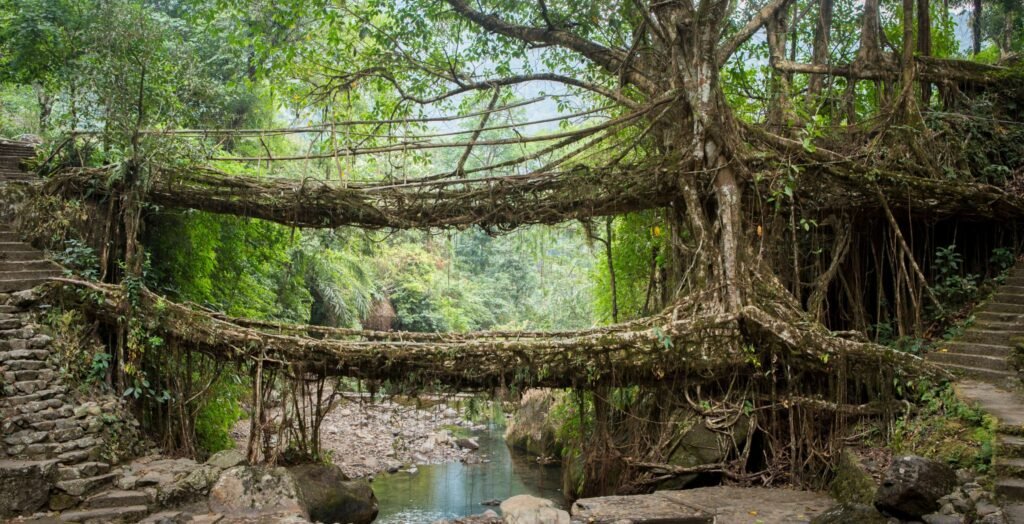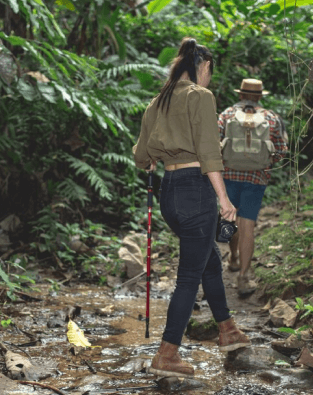In northeast India’s Meghalaya hills, there is a beautiful spot where nature and human imagination come together. The Living Root Bridges are a truly unique creation that has been made here. These bridges are not just ordinary ones made of stone, wood, or concrete.
They are instead bridges made from tree roots that have been shaped and led over many years to make strong, natural ways to cross rivers and streams. People from all over the world now know about the Living Root Bridges and go there to see this one-of-a-kind combination of nature and human work, making it a key highlight of Meghalaya tourism.
To build these bridges, the roots of the Ficus elastica tree are used. This tree is also known as the Indian rubber fig. The Khasi and Jaintia tribes of Meghalaya have been helping these roots cross streams for hundreds of years, building bridges that can last that long.
How to Reach Nongriat and the Living Root Bridges
It’s important to carefully plan a trip to see the live root bridges of Nongriat. You have to take an aeroplane, a train, a car, and then a long walk to get to the town.
By air
Umroi Airport in Shillong is the closest airport to Nongriat. It is about 40 kilometres from Cherrapunji (also called Sohra). There are, however, not many planes that go through this small airport.
This is why a lot of tourists choose to fly into Guwahati Airport instead, which is bigger and has flights to many Indian towns. You can take a cab or a shared car to get to Shillong from Guwahati. The trip takes about three to four hours.
By Train
Guwahati is the closest big train stop. Several Indian states send trains to this station. You can get to Shillong from the train station by cab or shared car.
By Road
To get to Cherrapunji (Sohra), you can take a cab or a private car from Shillong. There will be beautiful hills, woods, and waterfalls to see along the way. It takes about two to three hours to get there. From Sohra, you can get to the beginning of the walk to Nongriat.
Trekking to Nongriat

The only way to get to Nongriat is on foot. One-way treks of about 12 kilometres must be done. Depending on speed, this can take anywhere from 3 to 4 hours.Along the way, you’ll have to cross several streams, steep paths, and wooden stairs. The beautiful scenery makes every step worth it, even though it’s a dangerous hike.
When is the best time to see the Living Root Bridges in Meghalaya?
Winter (October–March): Winter is the best time to go. This area has cool and pleasant weather that makes hiking and sightseeing easy. If the weather is clear and the paths are dry, you’re less likely to slip.
Monsoon: From June to September, it rains a lot. This is the best time to see root bridges because the rivers flow fast and the woods look lush and green. But the tracks get muddy and slippery, and rivers may rise, which makes trekking dangerous. Only expert trekkers should try to make the trip during this time of year.
Summer (April–June): Meghalaya’s summer isn’t too hot, but it can get sticky. Still, now is a good time to go if you want to see the bridges with lots of fresh greenery around them without the heavy rains of the summer.
Root Bridges Made of Living Things in Nongriat
What do Living Root Bridges do?
Trees of the Ficus elastica family have roots that grow across streams and rivers to make living root bridges. While it takes twenty to thirty years for a bridge to become strong enough to use, the end result is truly amazing.
First, rubber trees are put down on both sides of a river. Frames made of bamboo help the young, bendy roots move through the water.
A bridge strong enough to hold many people’s weight is made as the roots get thicker and tangled with each other over time.
Different Kinds of Root Bridges
Bridges with only one root: People mostly use these simple bridges to cross small streams or gaps that aren’t very wide.

Double-decker bridge: The famous double-decker root bridge is in Nongriat. It is made up of two layers of bridges that are stacked on top of each other. People from all over the world have come to see this one-of-a-kind wonder.

Important in their culture, these bridges are more than just ways for the Khasi and Jaintia to cross rivers. They are a big part of their culture and are passed down from one family to the next. People from all walks of life work together on root bridges as community projects.
The work often takes decades and includes older people, adults, and children. They link towns, farms, and markets together, and they also link people with each other. They teach patience, teamwork, and respect for nature through the things they make and take care of.
Going on a walk to Nongriat and the Living Root Bridges
How to Get to Nongriat
The Trekking Base Camp in Sohra is where the trip to Nongriat starts. There are about 3,000 steep steps that lead down to the valley where Nongriat is. The trail goes through thick woods and over simple wooden or metal bridges. It also goes by small waterfalls and streams. Even though the walk is hard, the peaceful settings and stunning views make it worth it.
Level of Difficulty
The walk is thought to be mild to difficult. You’ll need to get up and down steep steps and rough roads, so you should be pretty fit. People who want to walk should wear sturdy shoes, bring water, and stop for breaks along the way. Slowing down is important because the climb back up from Nongriat is the hardest part for many people.
What to look forward to
You will be walking through dense woods that are full of the sounds of birds, bugs, and running water. Along the way, you might meet friendly locals, and you might see small farms tucked into the sides of hills. When the sky is clear, you can see the Khasi Hills in all their beauty.
Things to see along the way
The trip has more to see than just the living root bridges. The well-known Nohkalikai Falls, which is one of India’s largest waterfalls, can be seen close to Cherrapunji. It’s also possible to explore hidden caves and see mice, birds, and even small deer in the area. There is something special about every part of the trip, from the peace of a stream to the thrill of getting to the double-decker bridge.
Why are these bridges important?
There are several reasons why the living root bridges are important. They are very important to the people of Meghalaya for daily life. Villagers cross them to see family or go to the market, and kids depend on them to get to school. Farmers use them to get to their fields.
It would be much harder to live in this rainy, hilly area without these bridges. They’re also good for the neighborhood. They bring the community together and teach people how to work together, be patient, and value tradition.
They were built and are kept up by locals over many generations. Everyone helps take care of the bridges—men, women, and children—by directing young roots, getting rid of moss, and fixing damage. Besides that, the root bridges are good for the earth. They help the local wildlife by giving bugs, birds, mice, and even small animals like barking deer a place to live.
Moss and plants are made to grow, which is good for the forest’s health. Instead of taking down trees or building with concrete, the Khasi and Jaintia people use living things.
This way, they live with nature instead of against it, making the living root bridges a remarkable feature of the Northeast States of India.
Things to Do in Nongriat and at the Living Root Bridges
You can do a lot of different things once you get to Nongriat besides just looking at the buildings.
Explore the Double-Decker Root Bridge: The most popular and photographed bridge in Meghalaya is the Double-Decker Root Bridge, which you should check out.
The locals built it with two layers of living roots on top of each other. It is a unique and interesting sight.
It’s safe to walk on because the roots are strong, and you can enjoy the amazing craftsmanship that has been built up over decades.
Nature Walks and Photography: There are lovely nature walks in the area around Nongriat.
The town and nearby trails are great for taking a walk.You can enjoy the fresh air and hear the sound of water running.
Bring your phone or camera to take pictures of the beautiful scenery, root bridges, waterfalls, and town life.
The soft light in the morning and evening is great for photographers.
Swim in Natural Pools: A natural pool is a nice place to cool off after a long walk. You can find one near the root bridges.
These clear, cool pools were made by the river. You can swim in them or just dip your feet in them to rest.
Cultural Exploration: Meeting the Khasi people who live in Nongriat is one of the best things about going there.
The people there will let you talk to them, learn about their traditions, and see how they live in balance with nature.
A lot of Khasi people are happy to talk about their stories, farming, and how they take care of the bridges.
This is a one-of-a-kind chance to live in a way that is closely linked to the land.
Where to Stay in Saint-Ngaire
Simple Homestays
You can stay with local families in Nongriat who run small homestays.These spots are simple but cosy, and they give you a real taste of life in the country.
There is a bed, a simple bathroom and friendly hosts in most rooms.
Camping
You can camp near the living root bridges if you bring your own tent.It’s peaceful and unique to camp out under the stars, listening to the sounds of nature.
Make sure you only camp in places that are allowed and follow the rules to keep the area clean.
Best Place to Stay
Ritchell’s Homestay is a popular choice because you can stay with a local family, eat home-cooked Khasi food, and learn more about the culture.
Not only does staying in a homestay save you money, it also helps the neighbourhood.
What to Eat in Nongriat
Khasi Cuisine

In Nongriat, you can enjoy simple but delicious food. Common Khasi dishes include pork with bamboo shoot, rice with fish, and pickled vegetables. These meals taste especially satisfying after a day of trekking.
Local Snacks
Don’t miss trying lassi, a sweet or salty yogurt drink, and pahma, a local rice-based fermented drink. Both are perfect for cooling down after your trek or swim.
Tea and Snacks
Along the trail and in the village, you’ll find small kiosks and homestays offering snacks like chips, bananas, and local teas. These treats give you a good energy boost during your hike.
How much does it cost to go to the Living Root Bridges?
Most of the time, Nongriat and the living root bridges are cheaper to visit than other popular tourist places.
Licenses: Most of the time, you don’t need a special licence to visit the bridges. The village may, however, charge a small fee to enter, which helps keep the town and trail in good shape.
Costs of lodging: Depending on how comfortable it is and whether meals are included, most homestays charge between ₹300 and ₳700 per night. You can check prices ahead of time or get advice from local guides.
Costs of Trekking: There is a range of prices for hiring a local guide for the walk. The cost will depend on the length of the trek and the number of people who join.
Costs Not Included:Don’t forget to budget for things like gifts, food, snacks, and drinks. You could also leave a tip for your guide or homestay hosts to say thanks for all their help and kindness.
Advice on how to get to Nongriat and the Living Root Bridges
To make your trip fun and safe, just follow these easy steps
Prepare your body: If you’re not used to walking on rough, steep terrain, do some light training like walking or taking stairs before your trip. It can be pretty hard to get to Nongriat on foot.
Smart and Light Packing: Pack clothes that are light and easy to move around in. It’s best to wear good shoes, like hiking boots or sports shoes with good grip.Bring a small bag with you and put things like water, snacks, sunscreen, bug spray, a hat and a camera in it.
Regard the local way of life: Khasi people have strong ties to their past. Before taking pictures of people, you should always ask first, and you shouldn’t go into people’s homes or touch cultural things without their permission. Follow town rules and don’t throw trash on the ground to help protect the environment.
Keep yourself safe: When it rains, steps and bridges can get slippery, so be careful on the trails. Make sure you drink enough water and take breaks when you need them. Having a small first-aid kit with things like band-aids and cleaning cream is also a good idea.
Frequently Asked Questions (FAQs)
1. Is the walk to Nongriat good for first-timers?
Yes, people who aren’t very fit can finish the trek, but they should be ready for the long journey and steep 3,000 steps. Don’t rush, and take your time.
2. Can I go to the Living Root Bridges any time of the year?
You are welcome to come at any time of the year. But October through March is the best time because the paths are dry and the weather is cooler. It’s beautiful during the monsoon season (June–September), but the roads are slippery and hard to walk on.
3. How long does it take to walk to Nongriat?
It takes between 3 and 4 hours to walk one way, but it depends on how fast you walk and how often you stop to rest. Start your walk early in the day to avoid going through the dark.
4. When is the best time of year to go to the Living Root Bridges?
From October to March, when it’s cooler, is the best time to go. The natural pools are safe for swimming during this time.
5. Are there tours of the Living Root Bridges that are led by someone?
There are guides you can hire in both Sohra and Shillong. They will help you find your way on the trail, tell you stories about the bridges and Khasi culture, and make sure your trip is safe and fun.










